| ALL ABOUT GESSO |
 |
|
If you're new to painting - or if you only use pre-primed canvas - you may have seen the term "gesso" in passing, but never bothered looking into what it is or what it is used for.
This article outlines the history and uses of gesso (pronounced "jesso"), as well as how-to's on applying it and making your own from scratch.
|
SUMMARY
| WHAT IS GESSO? |
ACRYLIC GESSO STYLES |
HOW TO APPLY |
HOW TO MAKE |
An overview of:- Traditional Gesso
- Acrylic Gesso
- Soy-Based Gesso
|
- Student vs. Artist grade
- Heavy and hard gesso
- Colored gesso
|
What you need and the step by step procedure to prime your canvas or other surface with gesso. |
What you need and a suggestion of ratios for preparing your own, homemade gesso. |
|
| WHAT IS GESSO?
|
 |
Gesso is a plaster-like primer applied to surfaces prior to painting. Originally developed for oil painting on canvas, gesso is now used for a wide variety of media on almost any surface.
TRADITIONAL GESSO
Traditional gesso (Italian for gypsum) was made by mixing together rabbit-skin glue, chalk or gypsum, and white pigment. It was also called "glue gesso" or "Italian gesso". When added to a raw surface like wood, the gesso added "tooth" - roughness - which helped the paint adhere, and prevented it from soaking in. This meant less paint was required, and the colors stayed truer.
This original gesso could be used as a base for oil painting, egg tempura, any water-based paint (acrylics weren't invented yet), or painted onto any three dimensional surface in preparation for applying gold leaf. Because traditional gesso dried very hard, it was only suitable for rigid surfaces, and would crack and chip on flexible substrates
When canvas needed to be primed, linseed oil could be added to the gesso, giving it the flexibility required for the softer surface that might, in future, be rolled. This mixture was sometimes called "half-chalk ground".
ACRYLIC GESSO
Today, gesso can transform almost any rigid substrate - and stretched canvas as well - into a paintable surface, regardless of its original absorbency, slickness, or finish. Wood panels are one of the most common painting surfaces, though metal, plastic, and cardboard are suitable as well.
The most common type of gesso used today is acrylic gesso. It was invented in the 1950s by the brand Liquitex. In lieu of the animal glue of old, acrylic gesso uses a polymer latex, mixed with chalk, white pigment (usually titanium dioxide, which artists know as titanium white - it improves flexibility) and other chemicals that ensure longevity. Because it has no glue or gypsum, it is not technically gesso, but has retained the name. Essentially, modern gesso is just a painting primer.
Though this new version of gesso is ideal for acrylic paint, and suitable for most oil painting as well, it is not as absorbent like the traditional primer, and does not work for egg tempura.
In recent years, some oil artists have begun to question whether acrylic gesso is really a good choice for oil painting - it's thought a mismatch in the flexibility of the media can cause problems over time. None the less, companies that offer acrylic gesso, like Liquitex and Golden, maintain that it is suitable for both. One professional artist suggests using it most of the time for oil painting, but using an oil-based gesso for any major or important work.
SOY-BASED GESSO
Recently, an "eco" gesso has been introduced to the market. Using recycled soy products, this primer is "low-emitting", and uses a binder that is a mix of oil and acrylic. The addition of oil is said to make this type of gesso more suitable to canvas - it's more flexible - and may be better suited to use with oil paints.
|
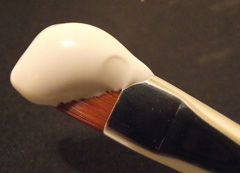
Gesso
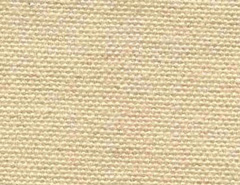
Canvas without gesso
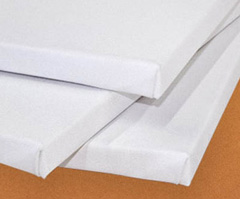
Canvas with gesso
|
| STYLES OF ACRYLIC GESSO
|
 |
|
Acrylic gesso is available in two different grades, which fall in to two price categories.
Student-grade gesso is less expensive, while Artist-grade gesso costs more. This is due to the ratio of pigment to filler. Not surprisingly, the artist-grade gesso has more pigment with less filler. It is generally thicker and more opaque (because of the pigment). However, for all but the most advanced artists, student-grade gesso is generally suitable. It may require an extra coat, but that is generally worth the savings.
Super Heavy gesso is also available, and doubles as a texturing agent and a primer.
Hard gesso is made to be sanded down after application (just an option for regular gesso). It is very thick, and after sanding results in full coverage as well as a flawlessly smooth surface. Very fine sandpaper (240 grit) is usually recommended for smoothing gesso.
Colored gessos are available from certain manufacturers. Though the artist can always mix acrylic paint or powdered pigment into the gesso, they can save time and supplies by purchasing pre-colored versions. Black is the most common after white, but colors like blue and yellow are available as well. Clear gesso is also sold.
Though generally offered in tubes and jars, there are spray gessos that make application easier. Of course, this version cannot be mixed with pigments for different colors.
In addition to adding color, texturizing gel can be mixed into gesso to create sculptural effects below the paint, in addition to sealing the surface.
|
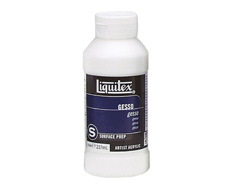
Liquitex Gesso
|
| HOW TO: APPLY GESSO TO A PAINTING SURFACE
|
 |
|
Depending on your painting surface, and your own plans for the project, you may need to apply as few as one or as many as a dozen layers of gesso. When preparing a picture frame for gilding with gold leaf, for instance, eight to ten thin coats are recommended.
What You'll Need:
- Large, flat brush
- Acrylic gesso
- Water, and/or colored pigment
- Sandpaper (optional)
What To Do:
- Open the tube or jar of gesso. If you are going to be mixing anything into it, transfer the desired amount into a different container (keep in mind whatever you add will increase the volume).
- Add some water to the gesso if it is too thick. Alternately, or additionally, you can add powdered pigments or acrylic paint to change the color of the gesso. Stir very well until the paint is smooth.
- Using a large brush - this will depend on the size of your canvas, but choose a dimension that will allow you to quickly and smoothly apply the gesso - apply one thin coat. Use long, even strokes, and try to minimize ridges created by the bristles. If necessary, you can gently go over those ridges with a dry brush immediately afterwards.
- Allow the layer to dry completely. Depending on the thickness of your application, and humidity, this can take anywhere from 2 to 12 hours. Once dry, if you require a smoother surface, sand if desired (may not be necessary for this first thin coat).
- Turn the gessoed surface 90 degrees and apply a second coat. This coat can have less water mixed in, if you prefer.
- Once the second coat has dried, sand the surface again if you want. If necessary, apply a third coat, and sand again.
- Once the last coat has dried, you're ready to paint!
|
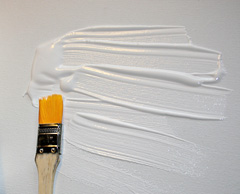
Watered-down gesso is applied across the canvas
|
| HOW TO: MAKE YOUR OWN GESSO
|
 |
|
If you're applying gesso to a great number of canvases, wood panels, or other surfaces, the cost of this primer can add up - and that's before you've even applied the high quality paints and mediums.
Depending on your requirements, it might be easier and cheaper to mix your own gesso. You can make some homemade gesso with easy-to-find and inexpensive materials. Be sure to test it out before you use it on a pricy canvas or under expensive paints!
What You'll Need:
- Talcum powder (baby powder)
- White craft glue
- White acrylic paint (inexpensive is fine)
- Water
Play around with the quantities of each ingredient until you get the opacity and consistency you require for your project. While many different versions of this recipe exist, one suggested ratio is:
- 1 part glue
- 2-3 parts water (the thicker the glue, the more water you'll need)
- 6 parts talcum powder
- White paint, as desired
Of course, if you can get your hands on calcium carbonate, that will work in place of the talcum powder, but I wouldn't recommend grinding blackboard chalk up in your blender!
|
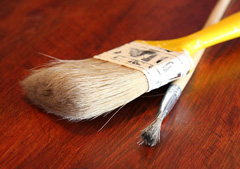
Apply gesso with a wide paintbrush
|
|
At KeenART Media, we offer various painting surfaces.
Our Artist's Canvas is sold by the foot, and pre-stretched on 3/4" or 1-3/8" stretcher bar frames. We offer unprimed, single-primed, and double-primed options.
With dozens of sizes to choose from, our Cradled Wood Panels are another great option for painting, collage, image transfers, and countless other art projects. They come unprimed, but can easily be prepped with a couple layers of acrylic gesso.
If you're working with something a little more unique, check out our variety of Mounting Boards. We sell matboard, foam board, aluminium composite, Sintra, and plexiglass in custom sizes. They'll be shipped to you all ready for your next project.
If you have questions about any of our services or products, don't hesitate to contact us. Our knowledgeable staff is always happy to assist with answers, advice, or suggestions.
|
|
© 2002-2025 - KeenART Media Ltd.
|
|
| |
|

